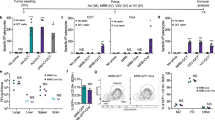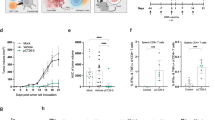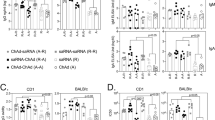Abstract
Antigen-specific cancer immunotherapy involves the delivery of tumor-associated antigen to the host for the generation of tumor-specific immune responses and antitumor effects. We hypothesized that different delivery systems may influence the pattern of antigen-specific immune response and the outcome of antitumor effect. We therefore evaluated recombinant vaccinia virus and naked DNA for the generation of antigen-specific immune responses and antitumor effects. We previously found that recombinant vaccinia and naked DNA vaccines containing the chimeric Sig/E7/LAMP-1 gene were capable of controlling the growth of HPV-16 E7-expressing tumor cells (TC-1). In this study, we performed a head-to-head comparison of optimized delivery of Sig/E7/LAMP-1 vaccinia and DNA vaccines using dose-escalating tumor challenge. At a dose of 1 × 106 TC-1 cells per mouse, Sig/E7/LAMP-1 DNA provided 100% protection against subcutaneous growth of tumors, while Vac-Sig/E7/LAMP-1 protected only 40% of the mice. Furthermore, Sig/E7/LAMP-1 DNA vaccines are capable of protecting against challenge with a more stringent subclone of TC-1 (TC-1 P2) established from TC-1 tumors that survived initial Sig/E7/LAMP-1 vaccinia vaccination. Immunological assays revealed that both vaccines induced comparable levels of CD8+ T cell precursors and anti-E7 antibody titers. Interestingly, Sig/E7/LAMP-1 vaccinia induced both E7-specific IFN-γ- and IL4-secreting CD4+ T cell precursors while Sig/E7/LAMP-1 DNA induced only E7-specific IFN-γ-secreting CD4+ T cell precursors. We also found that IL-4 knockout C57BL/6 mice vaccinated with Sig/E7/LAMP-1 vaccinia exhibited a more potent antitumor effect than vaccinated wild-type C57BL/6 mice in our tumor protection experiments. These results suggest that IL-4 may play a detrimental role in the antitumor effect mediated by vaccinia vaccines. Our findings suggested that DNA vaccines may provide better tumor protection than vaccinia vaccines employing the same gene, which may have implications in the future design of antigen-specific cancer immunotherapy.
This is a preview of subscription content, access via your institution
Access options
Subscribe to this journal
Receive 12 print issues and online access
$259.00 per year
only $21.58 per issue
Buy this article
- Purchase on Springer Link
- Instant access to full article PDF
Prices may be subject to local taxes which are calculated during checkout









Similar content being viewed by others
References
Pardoll DM . Cancer vaccines Nature Med 1998 4: 525–531
Chen CH, Wu TC . Experimental vaccine strategies for cancer immunotherapy J Biomed Sci 1998 5: 231–252
Wu T-C et al. Engineering an intracellular pathway for MHC class II presentation of HPV-16 E7 Proc Natl Acad Sci USA 1995 92: 11671–11675
Lin K-Y et al. Treatment of established tumors with a novel vaccine that enhances major histocompatibility class II presentation of tumor antigen Cancer Res 1996 56: 21–26
Chen CH et al. Gene gun-mediated DNA vaccination induces antitumor immunity against human papillomavirus type 16 E7-expressing murine tumor metastases in the liver and lungs Gene Therapy 1999 6: 1972–1981
Ji H et al. Targeting HPV-16 E7 to the endosomal/lysosomal compartment enhances the antitumor immunity of DNA vaccines against murine HPV-16 E7-expressing tumors Hum Gene Ther 1999 10: 2727–2740
Chen C-H et al. Boosting with recombinant vaccinia increases HPV-16 E7-specific T cell precursor frequencies of HPV-16 E7-expressing DNA vaccines Vaccine 2000 18: 2015–2022
Murali-Krishna K et al. Counting antigen-specific CD8 T cells: a reevaluation of bystander activation during viral infection Immunity 1998 8: 177–187
Tindle RW, Fernando GJ, Sterling JC, Frazer IH . A ‘public’ T-helper epitope of the E7 transforming protein of human papillomavirus 16 provides cognate help for several E7 B-cell epitopes from cervical cancer-associated human papillomavirus genotypes Proc Natl Acad Sci USA 1991 88: 5887–5891
Sher A, Coffman RL . Regulation of immunity to parasites by T cells and T cell-derived cytokines Annu Rev Immunol 1992 10: 385–409
Abbas AK, Murphy KM, Sher A . Functional diversity of helper T lymphocytes Nature 1996 383: 787–793
Fu EJ et al. Tumor-induced suppression of antitumor reactivity and depression of TCRzeta expression in tumor-draining lymph node lymphocytes: possible relationship to the Th2 pathway J Immunother 1997 20: 111–122
Hung K et al. The central role of CD4(+) T cells in the antitumor immune response J Exp Med 1998 188: 2357–2368
Schuler T et al. T helper cell type 1-associated and cytotoxic T lymphocyte-mediated tumor immunity is impaired in interleukin 4-deficient mice J Exp Med 1999 189: 803–810
Ferrick DA et al. Differential production of interferon-gamma and interleukin-4 in response to Th1- and Th2-stimulating pathogens by gamma delta T cells in vivo Nature 1995 373: 255–257
Zlotnik A, Godfrey DI, Fischer M, Suda T . Cytokine production by mature and immature CD4−CD8− T cells. Alpha beta-T cell receptor+ CD4−CD8− T cells produce IL-4 J Immunol 1992 149: 1211–1215
Stein-Streilein J, Sonoda KH, Faunce D, Zhang-Hoover J . Regulation of adaptive immune responses by innate cells expressing NK markers and antigen-transporting macrophages J Leukoc Biol 2000 67: 488–494
Townsend A et al. Defective presentation to class I-restricted cytotoxic T lymphocytes in vaccinia-infected cells is overcome by enhanced degradation of antigen J Exp Med 1988 168: 1211–1224
Feltkamp MC et al. Vaccination with cytotoxic T lymphocyte epitope-containing peptide protects against a tumor induced by human papillomavirus type 16-transformed cells Eur J Immunol 1993 23: 2242–2249
Lill NL, Tevethia MJ, Hendrickson WG, Tevethia SS . Cytotoxic T lymphocytes (CTL) against a transforming gene product select for transformed cells with point mutations within sequences encoding CTL recognition epitopes J Exp Med 1992 176: 449–457
Alexander-Miller MA, Leggatt GR, Berzofsky JA . Selective expansion of high- or low-avidity cytotoxic T lymphocytes and efficacy for adoptive immunotherapy Proc Natl Acad Sci USA 1996 93: 4102–4107
Barry MA, Johnston SA . Biological features of genetic immunization Vaccine 1997 15: 788–791
Bernstein DI . Effect of route of vaccination with vaccinia virus expressing HSV-2 glycoprotein D on protection from genital HSV-2 infection Vaccine 2000 18: 1351–1358
Sparwasser T et al. Bacterial DNA and immunostimulatory CpG oligonucleotides trigger maturation and activation of murine dendritic cells Eur J Immunol 1998 28: 2045–2054
Jakob T et al. Activation of cutaneous dendritic cells by CpG-containing oligodeoxynucleotides: a role for dendritic cells in the augmentation of Th1 responses by immunostimulatory DNA J Immunol 1998 161: 3042–3049
Ballas ZK, Rasmussen WL, Krieg AM . Induction of NK activity in murine and human cells by CpG motifs in oligodeoxynucleotides and bacterial DNA J Immunol 1996 157: 1840–1845
Porgador A, Mandelboim O, Restifo NP, Strominger JL . Natural killer cell lines kill autologous beta2-microglobulin-deficient melanoma cells: implications for cancer immunotherapy Proc Natl Acad Sci USA 1997 94: 13140–13145
Hahne M et al. Melanoma cell expression of Fas(Apo-1/CD95) ligand: implications for tumor immune escape Science 1996 274: 1363–1366
Seliger B, Maeurer MJ, Ferrone S . TAP off – tumors on Immunol Today 1997 18: 292–299
Maeurer MJ et al. Tumor escape from immune recognition: lethal recurrent melanoma in a patient associated with downregulation of the peptide transporter protein TAP-1 and loss of expression of the immunodominant MART-1/Melan-A antigen J Clin Invest 1996 98: 1633–1641
Piali L et al. Endothelial vascular cell adhesion molecule 1 expression is suppressed by melanoma and carcinoma J Exp Med 1995 181: 811–816
Chouaib S et al. The host-tumor immune conflict: from immunosuppression to resistance and destruction Immunol Today 1997 18: 493–497
Ji H et al. Antigen-specific immunotherapy for murine lung metastatic tumors expressing human papillomavirus type 16 E7 oncoprotein Int J Cancer 1998 78: 41–45
Acknowledgements
We would like to thank Drs Richard Roden and Robert J Kurman for helpful discussions. We thank Dr Ephraim Fuchs for providing C57BL/6 IL-4 knockout mice. We would also like to thank Howard Jen for superb technical assistance. This work was supported by NIH 5 po1 34582–01, U19 CA72108–02, RO1 CA72631–01, the Cancer Research Institute and the Richard W TeLinde endowment.
Author information
Authors and Affiliations
Rights and permissions
About this article
Cite this article
Chen, CH., Wang, TL., Ji, H. et al. Recombinant DNA vaccines protect against tumors that are resistant to recombinant vaccinia vaccines containing the same gene. Gene Ther 8, 128–138 (2001). https://doi.org/10.1038/sj.gt.3301370
Received:
Accepted:
Published:
Issue Date:
DOI: https://doi.org/10.1038/sj.gt.3301370



